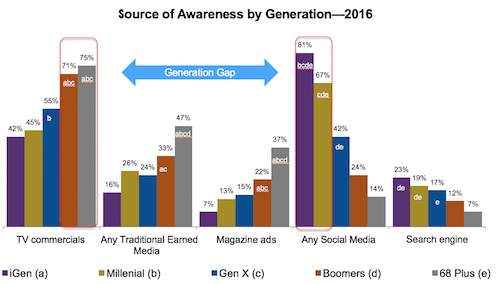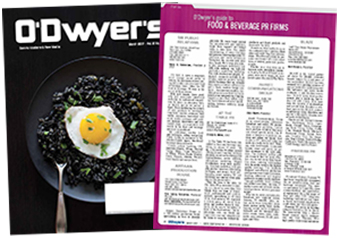Food was an unusually big news topic in 2016. Boston-based firm Schneider Associates in December published its Most Memorable New Product Launch Survey, an annual study that polled more than 1,000 consumers in a bid to rank the top 10 memorable product launches for the year, and reported that food took up an unusually large amount of media bandwidth in 2016, with eight food-related products making the list, a first in the study’s history.
|
|
Americans place a high valuation on food-related issues, but respondents belonging to the 18-to-34-year-old demographic seem to be particularly engaged by this topic. According to the annual Food News Study commissioned by New York agency Hunter Public Relations, which surveys Americans on their opinions regarding the top food-related news items each year, more than half of all Americans said they view food and nutrition stories as important, and more than a quarter — 26 percent — find these stories very important. Millennials this year were uniquely more likely than any other age group to emphasize the importance of food-related news stories, with more than two-thirds reporting that they responded behaviorally to at least one food-related story in 2016.
The survey, which polled more than 1,000 U.S. residents in October and asked them to name their three top food-related news stories for the year and whether those stories provoked any sort of behavioral change, reported that more than a third of this demographic — 37 percent — claimed they’d changed their behavior in light of Chipotle’s E. Coli Outbreak, which took the number-one food story slot in Hunter’s survey this year.
 |
Three of the top 10 stories in this year’s Hunter study pertained to restaurants in some way. Samara Farber Mormar, Executive Vice President of Insights and Strategy at Hunter PR, said this was unusual, considering topics involving eating out rarely make Hunter’s top 10 at all.
“The role that restaurants and dining out plays in consumers’ lives and popular culture is huge. Foodie culture continues to be on the rise, and there’s more interest in the food we eat and being in the know about hot restaurants and food trends, which is all due in part to the fact that you now have two generations that have been around long enough that they’re essentially foodie generations,” Mormar said.
A widening information gap
The Internet is quickly replacing traditional media as the source consumers turn to when researching and educating themselves on food, with more Americans now relying on social media, podcasts and online forums such as YouTube for nutrition and health advice, as well as recipes and food-related news. According to the Hunter survey, 17 percent of Americans are now getting recipes from videos on social media, a percentage now on par with U.S. cooking shows.
Millennials are leading this charge, and now cite social media posts from peers and media publishers as the de facto source for food news, with 20 percent of respondents stating they receive their food-related information from postings left by peers on Facebook, followed by news websites and posts made on the social media hub by media outlets and publishers (both 17 percent).
The continued digital migration for younger generations illustrates for marketers a gap in how different age groups are gathering information about new products, and the spate of recent food-related surveys indicates that split may be growing wider.
 |
Schneider’s MMNPL survey found that Millennials are less likely than older consumers to learn about new products through traditional media sources such as TV commercials, and this generation, along with Gen X consumers, are significantly more likely to rely on social media as a resource for finding out about new products than older cohorts.
Noel Fisher, Director of Integrated Media and Marketing at Schneider, told O’Dwyer’s that current data suggests younger consumers will continue to move away from traditional media as they increase their social and digital media consumption. Baby Boomers and older generations, meanwhile, have also shifted slightly toward social, but not at metrics significant enough to call it a trend.
“We began tracking generational differences in media consumption in 2013 in response to the growing industry focus on Millennials. In that first year, 57 percent of Millennials were using social media to learn about new products, while 55 percent were using TV and 38 percent using any source of traditional media. In 2016, we saw that only 45 percent of Millennials were using TV, 26 percent were using any kind of traditional media and 67 percent were using social media to learn about new products,” Fisher said.
Healthy but indulgent
Millennials value news on nutrition, health and food, but healthy eating isn’t seen as the be-all and end-all for this demographic. According to the Hunter survey, stories involving food safety and nutrition issues overall actually made a bigger impact among Gen X, Baby Boomers and Mature consumers in 2016, and members of these generations also placed a higher emphasis than younger consumers on eating healthy, paying attention to ingredients and the safety of the foods and beverages they consume.
 |
New York-based marketing and branding services agency The Halo Group, which recently conducted a study to gauge the health and nutrition-related mindset of Millennials, found that three-quarters of this age group see food not only as a means of satisfying hunger, but as an adventurous pastime, and regularly seek out new food trends as a source of entertainment.
The Halo Group study also reported that Millennials prefer to eat in groups and share their experiences through social media on sites such as Instagram and Facebook. The Hunter survey reiterated this, finding that Millennials more than any other generation were inspired by news items they saw to share their food-related opinions via social media. The Hunter survey also found Millennials are now paying more attention to the role politics plays in food brands.
“Consumers are paying more and more attention to marketing,” Mormar said. “Brands have become popular in our discourse; there’s this acknowledgment now that brands and marketers are engaging with you and talking to you, and social media has helped create this role of the consumer as armchair marketer. People will now go on a brand’s Facebook page and comment on the effectiveness or ineffectiveness of a campaign. They expect to have relationships with brands, and the more brands that have a one-to-one relationship and conversation through social media the more consumers will be conscious of that practice.”



 What the biggest meal of the day can teach us about serving up effective nutrition communications campaigns.
What the biggest meal of the day can teach us about serving up effective nutrition communications campaigns. Tips to refine and amplify your CPG brand strategy to win in 2024 and beyond.
Tips to refine and amplify your CPG brand strategy to win in 2024 and beyond. Strategic communications strategies for success in the growing “food is medicine” movement.
Strategic communications strategies for success in the growing “food is medicine” movement. How brands can authentically communicate sustainability issues and create a brand experience that’s compatible with consumers’ values.
How brands can authentically communicate sustainability issues and create a brand experience that’s compatible with consumers’ values. Communicating the effects that climate change and a growing world population have on our food system—and why change is needed.
Communicating the effects that climate change and a growing world population have on our food system—and why change is needed.


 Have a comment? Send it to
Have a comment? Send it to 
No comments have been submitted for this story yet.